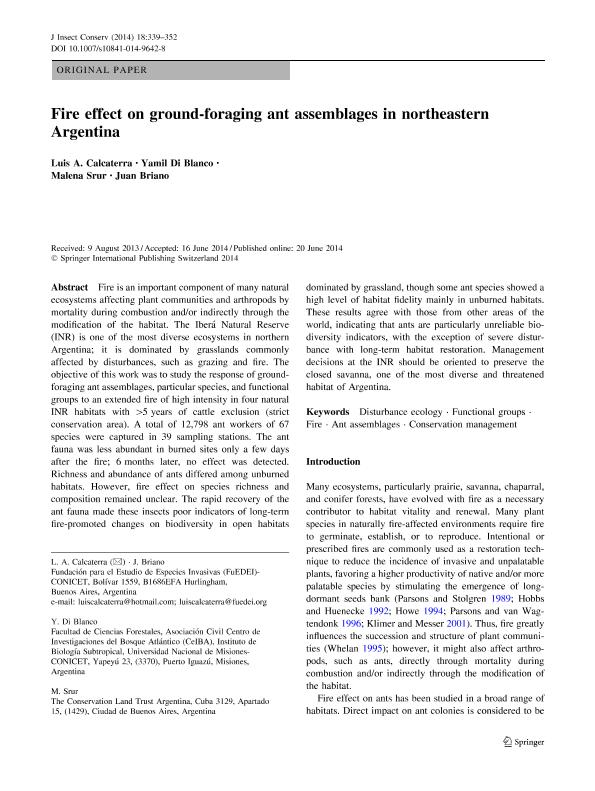Artículo
Fire effect on ground-foraging ant assemblages in northeastern Argentina
Fecha de publicación:
06/2014
Editorial:
Springer
Revista:
Journal Of Insect Conservation
ISSN:
1366-638X
e-ISSN:
1572-9753
Idioma:
Inglés
Tipo de recurso:
Artículo publicado
Clasificación temática:
Resumen
Fire is an important component of many natural ecosystems affecting plant communities and arthropods by mortality during combustion and/or indirectly through the modification of the habitat. The Iberá Natural Reserve (INR) is one of the most diverse ecosystems in northern Argentina; it is dominated by grasslands commonly affected by disturbances, such as grazing and fire. The objective of this work was to study the response of groundforaging ant assemblages, particular species, and functional groups to an extended fire of high intensity in four natural INR habitats with [5 years of cattle exclusion (strict conservation area). A total of 12,798 ant workers of 67 species were captured in 39 sampling stations. The ant fauna was less abundant in burned sites only a few days after the fire; 6 months later, no effect was detected. Richness and abundance of ants differed among unburned habitats. However, fire effect on species richness and composition remained unclear. The rapid recovery of the ant fauna made these insects poor indicators of long-term fire-promoted changes on biodiversity in open habitats dominated by grassland, though some ant species showed a high level of habitat fidelity mainly in unburned habitats. These results agree with those from other areas of the world, indicating that ants are particularly unreliable biodiversity indicators, with the exception of severe disturbance with long-term habitat restoration. Management decisions at the INR should be oriented to preserve the closed savanna, one of the most diverse and threatened habitat of Argentina.
Archivos asociados
Licencia
Identificadores
Colecciones
Articulos(CCT - NORDESTE)
Articulos de CTRO.CIENTIFICO TECNOL.CONICET - NORDESTE
Articulos de CTRO.CIENTIFICO TECNOL.CONICET - NORDESTE
Citación
Calcaterra, Luis Alberto; Di Blanco, Yamil Edgardo; Srur, Malena; Briano, Juan; Fire effect on ground-foraging ant assemblages in northeastern Argentina; Springer; Journal Of Insect Conservation; 18; 3; 6-2014; 339-352
Compartir
Altmétricas




